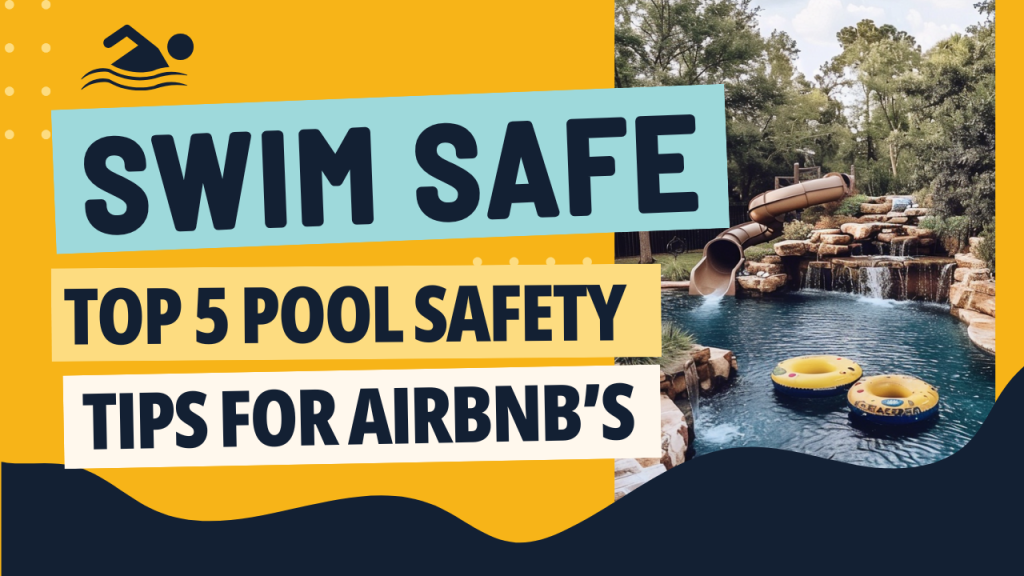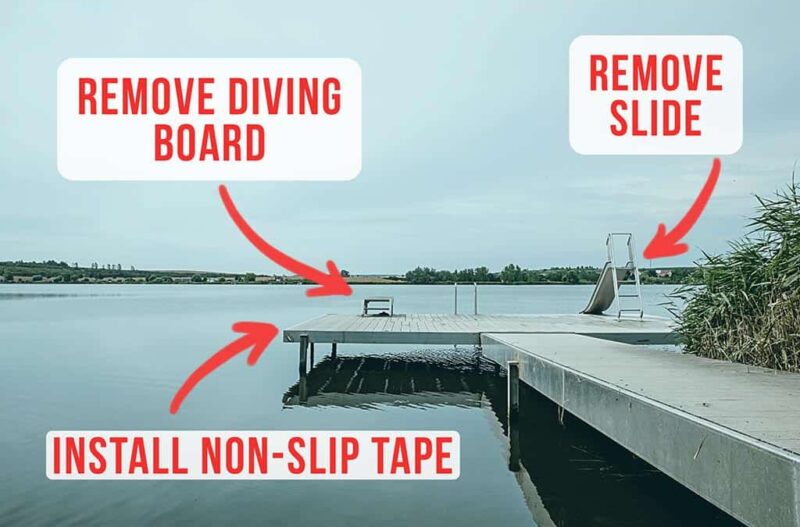Waterfront Vacation Rental Safety Concerns Every Host Should Know
Promoting a waterfront vacation rental can set you apart in the short-term rental industry especially when guests are looking to escape the summer heat or take part in an ice fishing adventure.
As a short-term rental host with a waterfront property, you may not initially think of the risks associated with this particular amenity. However, in addition to the heightened risk short-term rentals are already exposed to, if your property is located on the water, your risk exposure increases exponentially more.
- Lakefront Risk Management Tips for STRs
- Install Clear “Swim at Your Own Risk” Signage
- Provide Accessible Water Rescue Equipment
- Remove Slides and Diving Boards from Your Airbnb
- Airbnb Host FAQ: “What Pool Slides Are Safest for my Vacation Rental?”
- Avoid Providing Water Toys, Floats & Inflatables from Your STR
- Include Safety Guidance for Small Watercraft Use
- Superhost FAQ: “Should I require guests to sign an Airbnb kayak waiver?”
- Prepare for Ice and Winter Hazards

Waterfront Safety: Manage the Risks of Lake Properties
Short-term rental homes are inherently risky — guests are staying in an unfamiliar place, expect the same safety standards of a hotel stay, and their guard may be down while on vacation. Mix in slippery surfaces, risk of drownings, and use of watercrafts, and it’s clear why hosts face increased risk with waterfront short-term rentals. Without proactive safety measures, hosts may face claims of negligence if an injury occurs, it can potentially lead to costly legal battles and out-of-pocket expenses.
When it comes to short-term rentals, liability doesn’t stop at your property line. Providing amenities like kayaks or paddleboards may entice your guests, but they also increase the potential for accidents that traditional insurance may not cover. This is why proactive safety measures aren’t just helpful, they’re essential. By implementing key waterfront safety tips and carrying comprehensive short-term rental insurance, you can better protect your liability. Here’s how you can take charge of safety for the best waterfront hosting.
Address Off-Site and Amenities Risks at Your Waterfront STR
Most traditional insurance policies weren’t designed with vacation rentals—or their unique risks—in mind. One of the biggest gaps? Liability coverage that stops at your property line. If a guest gets hurt using one of your amenities off-site—like a kayak, paddleboard, or bike—your current policy likely has no obligation to respond.
Traditional insurance policies that carry personal liability or premise liability are weak in terms of liability coverage for incidents that occur on or around your waterfront vacation rental property.
This means that incidents beyond your property line are likely excluded by your Homeowners or Landlord insurance. For example, “premises liability” does not cover claims off-premises. Therefore, a lawsuit arising from an amenity that takes your guest off-premises, like providing bicycles at your beach home or kayaks at your lakefront rental, won’t be covered.
This doesn’t mean you shouldn’t rent your waterfront property with these added amenities but rather work to identify and address risks before guests arrive as well as have robust insurance protection for when they ultimately do happen
Lakefront Risk Management Tips for STRs
Taking steps toward safety and risk management, like placing non-slip tape on your dock, could help prevent slips and hazardous falls. Couple this approach with an insurance policy that includes off-premises liability and does not exclude guest use of amenities (small watercrafts, golf carts, etc.), and you can greatly reduce the risk to your business.
Install Clear “Swim at Your Own Risk” Signage
As a host, you never know who will be staying at your short-term vacation rental. To prioritize guest safety, it’s crucial to make guests aware that swimming is at their own risk by installing a “swim at your own risk” sign. This simple step can help prevent accidents and liability issues. For example, in 2024, Airbnb and the host of a waterfront New York property were sued for negligence after three people drowned due to an unmarked underwater drop-off between the host’s pier and floating dock. Clear signage can help ensure guests are fully aware of potential hazards in and around the water.
By publicly posting “swim at your own risk” signage, notifying guests and potential trespassers of the waterfront risk, you are distancing yourself from a lawsuit and reducing your negligence. Signage, paired with following pool safety standards can help inform guests and lessen your liability exposure.
5 Airbnb Pool Safety Tips
Better protect yourself from liability claims with these pool safety tips.

Provide Accessible Water Rescue Equipment
You’ve probably noticed that when you stay at a hotel with swimming access, there are several types of poolside warnings posted, water safety equipment nearby, and sometimes, on-duty lifeguards.
Hosts should make rescue and safety equipment easily available for guests at your waterfront rental property. Readily accessible gear, like U.S. Coast Guard-approved life rings, pool hooks, or life jackets, show preparedness for potential water emergencies. This proactive approach not only protects your guests but also reduces your legal liability related to negligence.
Remove Slides and Diving Boards from Your Airbnb
Although a slide or diving board might seem like fun pool features for guests, these poolside amenities are huge liabilities for your short-term rental. A springboard or pool slide may attract more renters and drive more bookings, but in the end, the loss is far greater than the gain if someone were to get injured.
This safety concern can open your business up to unnecessary legal risk in the event of an injury. Many insurance providers may require you to remove your diving board and slide to diminish the liability concern and potential for negligence.
Airbnb Host FAQ: “What Pool Slides Are Safest for my Vacation Rental?”
If you are set on keeping the pool slide at your vacation rental, it’s important to keep in mind what type of slide you have, since some are safer than others. While enclosed waterslides are often acceptable, pool or dock slides can turn into a dangerous situation, especially considering that it’s an open slide with no barrier to keep a person from flying out and injuring themselves.

Avoid Providing Water Toys, Floats & Inflatables from Your STR
Water inflatables, floats, and pool toys might not seem like a potential concern at first, but by providing pool floats and inflatables at your rental, you are inadvertently encouraging those who may not be the best swimmers to take a dip, which could result in drowning.
It is best that you do not provide any pool inflatables, floaties, or toys to guests at your waterside rental. If your guests bring their own to use, ensure that all inflatables are removed before the next group of guests arrives. Instead, opt for safety floatation devices as mentioned above like safety rings certified by the U.S. Coast Guard.
Include Safety Guidance for Small Watercraft Use
If you offer paddleboats, paddleboards, kayaks, or canoes at your waterfront vacation rental, it’s important to understand that rescue and safety equipment should be a priority for your guests, especially since there are no lifeguards on duty.
It’s easier to spot potential leaks or cracks on hard sided, non-motorized watercraft by your turnover team compared to inflatable options. If issues are spotted, be sure to promptly repair or remove the amenity from use at the property.
“Always provide guests with as much information as possible. You must assume they are visiting from a place they don’t use kayaks often, if at all,” said Justin Ford, short-term rental safety expert, in Breezeway’s Watercraft Safety video.
If providing watercraft amenities at your short-term rental, it’s important to ensure that your short-term vacation rental insurance policy covers amenities used off your property. Off-premises liability insurance can be found in the unique Commercial Homeowners insurance policy by Proper Insurance.
Superhost FAQ: “Should I require guests to sign an Airbnb kayak waiver?”
A signed waiver might relieve you of some liability in the instance of a claim, but it isn’t a substitute for comprehensive safety measures and clear communication of potential risks. Waivers are limited in their ability to protect you from negligence claims, and they don’t eliminate your responsibility for providing a safe environment.
The tragic Fox Lake incident, where a guest drowned due to inadequate safety precautions while canoeing, illustrates the severe risks associated with offering water activity amenities without taking the appropriate safety and insurance precautions. Make sure your short-term rental insurance includes coverage for off-premises liability to protect yourself and your business. Proactive steps combined with the right insurance are crucial for minimizing risks and ensuring guest safety.
Prepare for Ice and Winter Hazards
Is your short-term rental around ice or snow during certain months? These conditions bring the risks of guests walking on frozen lakes, snowslides, icicles falling off your roof, ice skating, slip-and-falls occurring from icy sidewalks, and more.
It’s important to inform and recommend that your guests take note of these concerns and consider including a waiver in your house rules during the winter months, especially if your listing encourages guests to take part in winter activities like sledding. We also strongly recommend that you keep your rescue equipment handy during cold months, install warning signs for ice and snow hazards, and take other wintertime safety precautions for STRs.
Essential Waterfront Safety Tips for Hosts
Concerned About Offering Kayaks, Paddleboards or Other Water Amenities? Gain Peace of Mind Through Proper’s Underwriting Process
As a short-term rental host, you are responsible for your guests’ safety. Implementing safety standards for waterfront properties is an underwriting requirement at Proper Insurance. Waterfront access is identified as a safety concern due to the high number of injuries or fatalities and subsequent lawsuits involving these items.
Underwriters may ask that you make changes to your short-term vacation rental, such as adding non-slip tape, in order to continue the insurance contract. However, if there was an injury at your property your liability insurance would respond.
Even if these requirements may seem like a barrier to entry, there is usually a grace period in which underwriters will notify you of potential risks and give you an opportunity to correct the issue without a gap in coverage.
Choosing a carrier with experienced short-term rental underwriters means that they’ve seen thousands of listings and hundreds of lawsuits, making it easy to identify issues before an accident.
Upgrade Your Short-Term Vacation Rental Insurance Today
Interested in a policy to protect you and your business from liability and damage claims? Proper’s robust policy is built to include amenities and off-premise liability protection. Because why make something an add-on when liability is one of the biggest risks a vacation rental host can face?
Proper Insurance is the nation’s leading short-term vacation rental insurance provider, with the most comprehensive policy on the market. We protect homes in all 50 states and the District of Columbia, with unmatched coverage for your property, revenue, and business liability, customized to include guest-caused theft/damage, liquor liability, amenity liability insurance (bikes, kayaks, hot tub, etc.), bed bugs, squatters, and more.



